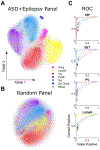A Role for Vasoactive Intestinal Peptide Interneurons in Neurodevelopmental Disorders
- PMID: 33794534
- PMCID: PMC8440337
- DOI: 10.1159/000515264
A Role for Vasoactive Intestinal Peptide Interneurons in Neurodevelopmental Disorders
Abstract
GABAergic inhibitory interneurons of the cerebral cortex expressing vasoactive intestinal peptide (VIP-INs) are rapidly emerging as important regulators of network dynamics and normal circuit development. Several recent studies have also identified VIP-IN dysfunction in models of genetically determined neurodevelopmental disorders (NDDs). In this article, we review the known circuit functions of VIP-INs and how they may relate to accumulating evidence implicating VIP-INs in the mechanisms of prominent NDDs. We highlight recurring VIP-IN-mediated circuit motifs that are shared across cerebral cortical areas and how VIP-IN activity can shape sensory input, development, and behavior. Ultimately, we extract a set of themes that inform our understanding of how VIP-INs influence pathogenesis of NDDs. Using publicly available single-cell RNA sequencing data from the Allen Institute, we also identify several underexplored disease-associated genes that are highly expressed in VIP-INs. We survey these genes and their shared related disease phenotypes that may broadly implicate VIP-INs in autism spectrum disorder and intellectual disability rather than epileptic encephalopathy. Finally, we conclude with a discussion of the relevance of cell type-specific investigations and therapeutics in the age of genomic diagnosis and targeted therapeutics.
Keywords: Autism; Epilepsy; Interneurons; Vasoactive intestinal peptide.
© 2021 S. Karger AG, Basel.
Conflict of interest statement
Conflict of Interest Statement
The authors have no conflicts of interest to declare.
Figures



References
-
- Acsády L, Görcs TJ, Freund TF. Different populations of vasoactive intestinal polypeptide-immunoreactive interneurons are specialized to control pyramidal cells or interneurons in the hippocampus. Neuroscience. 1996;73(2):317–34. - PubMed
Publication types
MeSH terms
Substances
Grants and funding
LinkOut - more resources
Full Text Sources
Other Literature Sources
Medical

